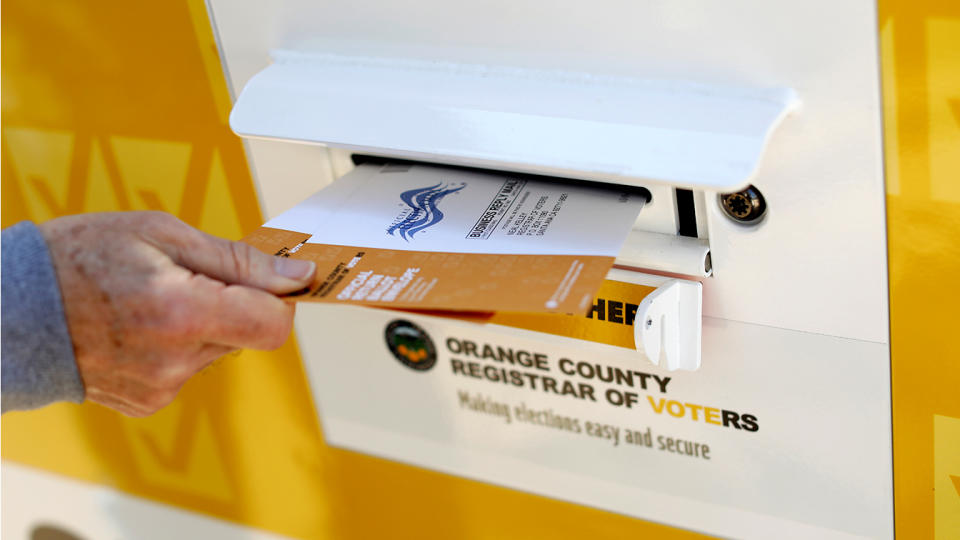Political realities may dilute GOP opposition to mail-in voting amid coronavirus
WASHINGTON — Republican lawmakers have so far blocked attempts to prepare for massive mail-in balloting in the presidential election. But Democrats think that resistance is likely to fade as they realize that the coronavirus will keep their own voters from the polls this fall.
“Their reticence will get diminished to some extent when they do realize that some of the people who may not be able to vote or afraid to vote are not necessarily all Democrats,” said Joe Trippi, a veteran Democratic political consultant.
“Right now, they might see New York and not be all that worried about it: ‘Let New York deal with its ballots.’ But there are a lot of their voters in Florida who might not vote, who might not be willing to go to the polls. A lot of Democrats too,” Trippi told Yahoo News.
“I think both sides should find some common ground and figure this out. Forget about the politics. In a worst case scenario … the people who might be afraid of voting — or might be sick and can’t vote — is not a group of people with one party or another,” he said.
But so far, Republican lawmakers in Congress have shown no desire to partner with Democrats to mandate that all states be prepared for a fall election conducted mostly through mail-in ballots.
Democrats proposed $4 billion to help states get ready for a mail-in election this fall, as part of the rescue package signed into law last week. But Republicans agreed to only $400 million of that.

Meanwhile, a growing number of states that have yet to hold primary elections are quickly moving to increase their mail-in ballot capacity, or in some cases eliminating in-person voting altogether.
The Kansas Democratic Party on Monday shifted its May 2 primary to an all-mail election, joining several other states in doing so, including Maryland, which is led by a Republican governor, Larry Hogan.
The Democratic parties in Kansas, Hawaii and Wyoming, responding to encouragement by the Democratic National Committee, had already planned to mail ballots to all Democratic voters ahead of their party primaries and caucuses.
It’s that kind of advance planning that will be needed for the fall elections. No one really knows what life in America will be like months from now, and how the coronavirus pandemic will affect public life at that point.
“I think we need to be prepared … because we don’t know what the health situation will be in the fall,” said Megan Lewis, co-founder and executive director of Voting Rights Lab, a group that looks to expand voting access.
The Voting Rights Lab website states it even more bluntly: “Our election system is unprepared for the current pandemic. The only way to ensure the continued functioning of our democracy and the safety of our citizens is for every state to provide every American with access to a mail ballot. Yet in order for large-scale absentee voting to be secure and effective by November, election officials must begin working to adapt state election systems now.”
And in some cases, state officials are moving this direction. Georgia is controlled by Republicans, but they have decided to send every registered voter a mail-in ballot.
In Wisconsin, however, Republicans in the state legislature have resisted calls from Gov. Tony Evers, a Democrat, to send mail-in ballots to every voter.
And on Tuesday, some members of the Wisconsin Board of Elections expressed deep misgivings about the state’s ability to carry out a safe and functional primary on April 7. The state is having to close multiple polling places due to a severe shortage of poll workers, and Democratic members of the board said election officials will not be able to count all the absentee ballots that are likely to be turned in.

“There’s an avalanche coming at the clerks,” said Elections Commissioner Mark Thomsen at a meeting of the commission that was conducted remotely and streamed online.
States will need more than $400 million to conduct a robust mail-in ballot election this fall with many millions of voters, according to the Brennan Center for Justice, a nonprofit advocacy group at New York University. Instead, it would be a massive undertaking that would cost at least $2 billion.
Yet in Congress, Republicans have yet to show any interest in working with Democrats to allocate that kind of funding to help states prepare, according to congressional staff and campaign operatives who spoke to Yahoo News on the condition they not be identified.
“The conversation at the federal and national level is totally disconnected,” Lewis told Yahoo News.
Republicans have ideological concerns about the federal government dictating to states how to run their elections, and there is also suspicion among conservatives about abuse of the system in absentee and mail-in balloting.
But, like Trippi, Lewis said she thinks that political self-interest may change that calculation for Republicans.
“If we are in a situation where there is some quarantine going in November … that is not going to respect or regard any party or affiliation,” she said.
Lewis’s group is also focused on making sure that even as states move to more mail-in voting, they don’t implement rules that would make it harder for poor and marginalized people to vote, such as requiring a mail-in ballot to be notarized.
And then there is the challenge of educating voters on how to cast mail-in ballots.
“Most voters are not going to know how to turn out, how to vote,” Lewis said. “We are going to really need to educate voters … or you’re going to find that many voters are going to be left out.”
_____
Click here for the latest coronavirus news and updates. According to experts, people over 60 and those who are immunocompromised continue to be the most at risk. If you have questions, please reference the CDC and WHO’s resource guides.
Read more:

 Yahoo News
Yahoo News 


